Difference Between Intracellular and Extracellular Fluids
The key difference between intracellular and extracellular fluids is that the fluid inside the cell is intracellular fluid, while the fluid outside the cell is extracellular fluid.
A cell is the basic structural and functional unit of life. A cell membrane surrounds the cell, separating the cell interior and external environment. Both cell interior and exterior have to be in ideal conditions in order to perform its functions at the optimum level. Hence, the compositions of intracellular and extracellular fluids are extremely important in this regard. Therefore, it would be important to explore the interior and the exterior of the cells.
CONTENTS
1. Overview and Key Difference
2. What are Intracellular Fluids
3. What are Extracellular Fluids
4. Similarities Between Intracellular and Extracellular Fluids
5. Side by Side Comparison – Intracellular vs Extracellular Fluids in Tabular Form
6. Summary
What are Intracellular Fluids?
Intracellular fluid, also known as the cytosol or the cytoplasmic matrix, is a liquid with many properties to ensure the proper maintenance of the cellular processes. Intracellular fluid is present only in the interior of the cell, and the cell membrane is its boundary. The membranes of organelles separate cytosol from the matrices of organelles. Many of the metabolic pathways take place in the intracellular fluid in both prokaryotes and eukaryotes. However, eukaryotic metabolic pathways are more common inside organelles than in the cytosol.

Figure 01: Cytoplasm
The composition of the intracellular fluid is important to know as it contains mostly water with some ions such as sodium, potassium, chloride, and, magnesium. Due to the presence of amino acids, water-soluble proteins, and other molecules, the cytosol has many properties. Despite the fact that there is no membrane to localize the contents of cytosol, there are some confinements of the intracellular fluid that take place through concentration gradients, protein complexes, cytoskeletal sieving, and protein compartments.
It is important to notice that cytoskeleton is not a part of the intracellular fluid, but its structures cause some of the large molecules to be trapped in some places. The intracellular fluid does not perform a specific duty, but it aids in many functions including signal transduction within organelles, providing a place for cytokinesis and protein synthesis, transportation of molecules, and many other.
What are Extracellular Fluids?
Extracellular is the fluid found outside the cells. In other words, extracellular fluid is the body fluid that surrounds cells and tissues. Extracellular fluids provide required nutrients and other supplements to the membrane-bound cells. It mainly consists of sodium, potassium, calcium, chlorides, and bicarbonates. However, the presence of proteins is very rare in extracellular fluid. The pH of the extracellular fluid is around 7.4, and this fluid has the buffering capacity to a considerable extent, as well.

Figure 02: Extracellular Fluid
The presence of glucose in the extracellular fluid is important in regulating homeostasis with cells, and the usual concentration of glucose in humans is five mill molars (5 mM). Mainly, there are two major types of extracellular fluids known as interstitial fluid and blood plasma. All those discussed factors are the main properties and constituents of interstitial fluids, which is roughly about 12 litres in a fully-grown human. The total volume of blood plasma is about three litres in a human.
What are the Similarities Between Intracellular and Extracellular Fluids?
- The barrier between intracellular and extracellular fluid is the cell membrane.
- Fluids and molecules travel between intracellular and extracellular fluids.
- The level of osmotic pressure remains approximately equal between intracellular and extracellular fluids.
- Both fluids are mainly composed of water.
- Glucose is present in both fluids.
What is the Difference Between Intracellular and Extracellular Fluids?
Intracellular fluid is the liquid present inside the cells while extracellular fluid is the fluid present outside the cells. Thus, this is the key difference between intracellular and extracellular fluids. Intracellular fluid accounts for a higher proportion of the total liquid volume while extracellular fluids account for a smaller proportion of the total liquid. This is also a difference between intracellular and extracellular fluids. Intracellular fluid contains proteins and amino acids. But, extracellular fluid lacks proteins and amino acids. Hence, this is another major difference between intracellular and extracellular fluids.
The below infographic summarizes the difference between intracellular and extracellular fluids comparatively.

Summary – Intracellular vs Extracellular Fluids
Intracellular and extracellular fluids are two types of liquids present in living organisms. Intracellular fluid is present inside the cells while extracellular fluid is present outside the cells. This is the key difference between intracellular and extracellular fluids. Both intracellular and extracellular fluids contain more water.
Reference:
1. “Intracellular Fluid: Definition & Composition.” Study.com, Available here.
2. “Boundless Anatomy and Physiology.” Lumen, Available here.
Image Courtesy:
1. “2702 Fluid Compartments ICF ECF” By OpenStax College – Anatomy & Physiology, Connexions Web site, Jun 19, 2013 (CC BY 3.0) via Commons Wikimedia
2. “Simple diagram of yeast cell (en)” By domdomegg – Own work (CC BY 4.0) via Commons Wikimedia
ncG1vNJzZmivp6x7pbXFn5yrnZ6YsqOx07CcnqZemLyue8OinZ%2Bdopq7pLGMm5ytr5Wau261za2pmpuVobm2uMCrZJqmlGLDtHnEsaurmZOaua3By5qpZp6cqralv44%3D